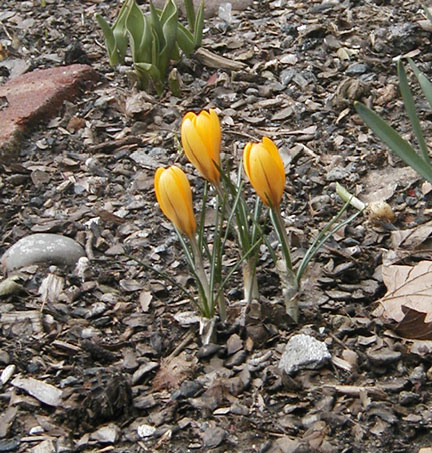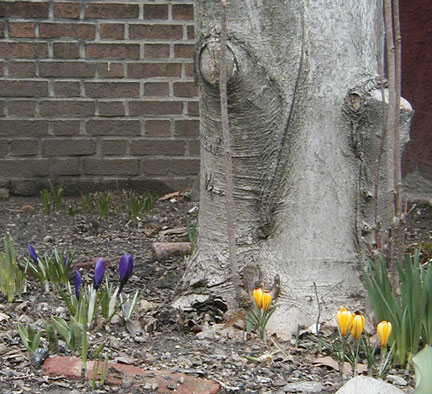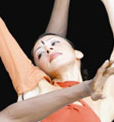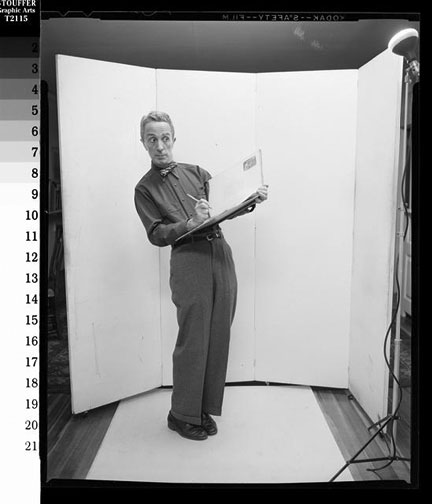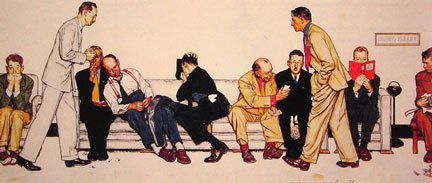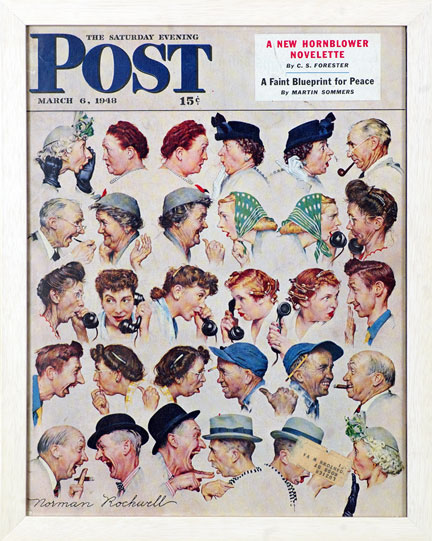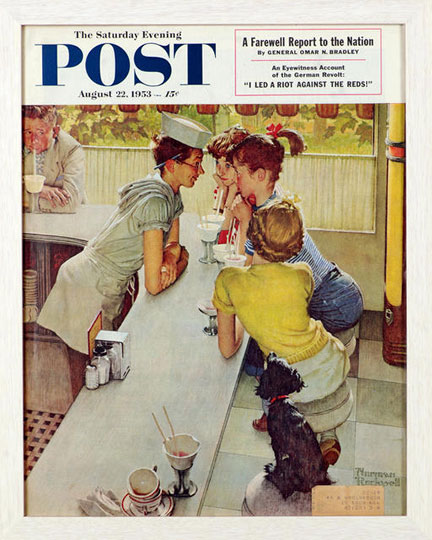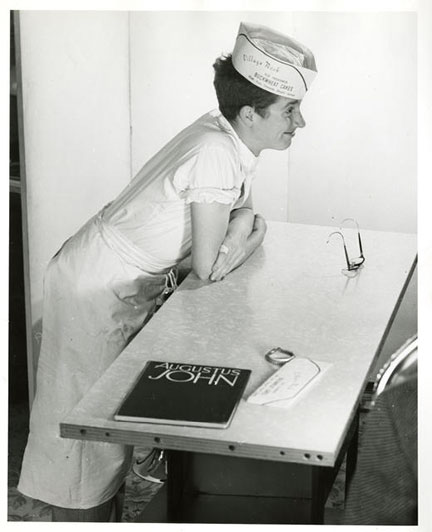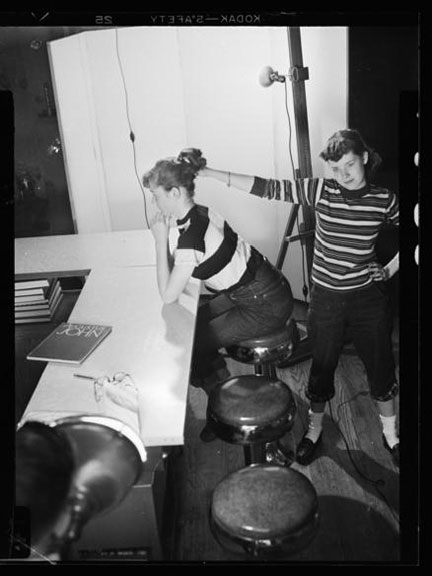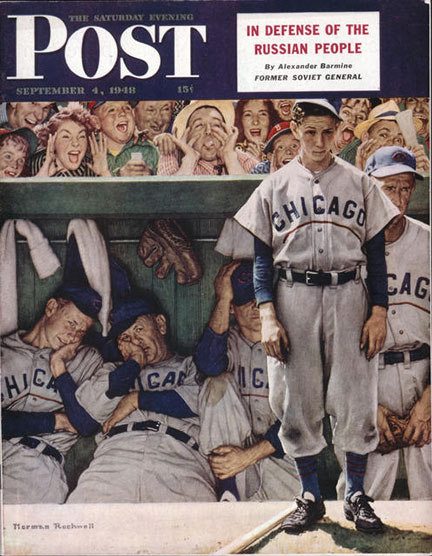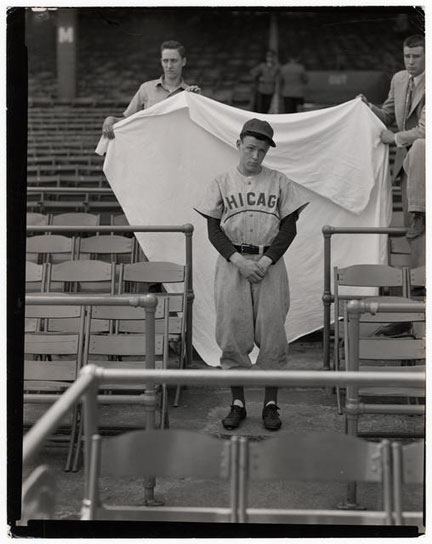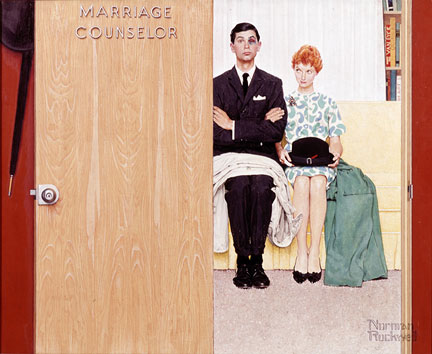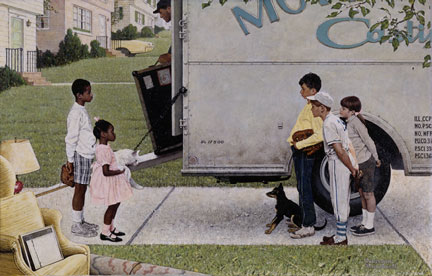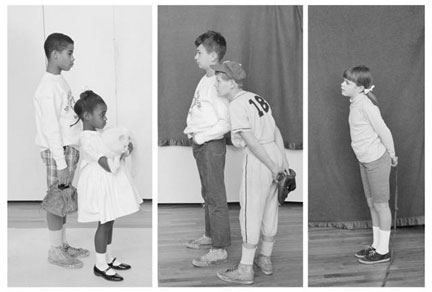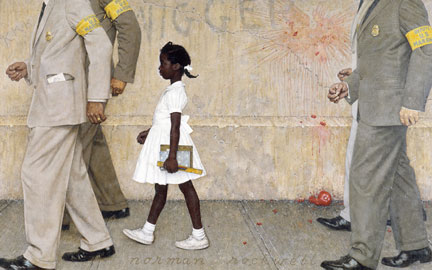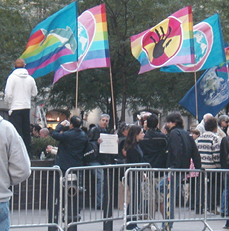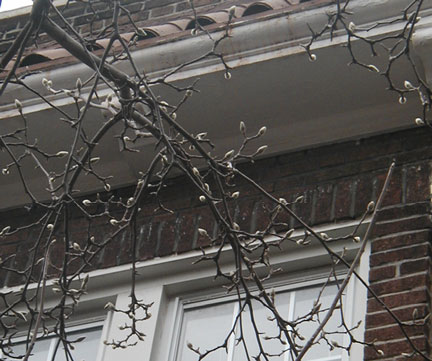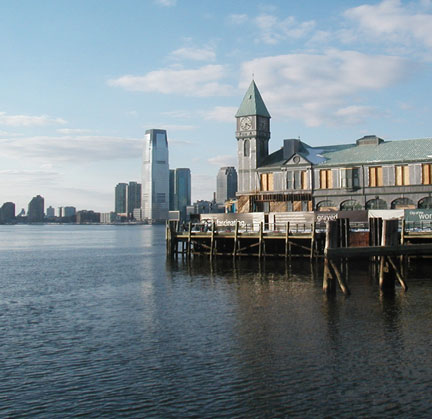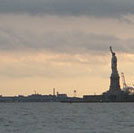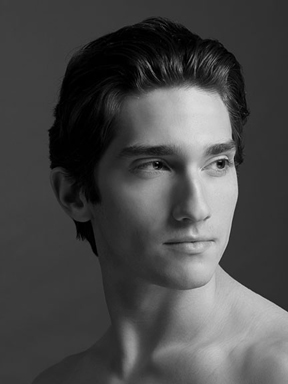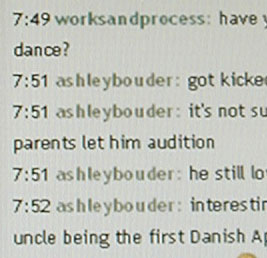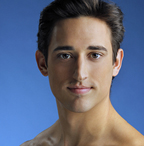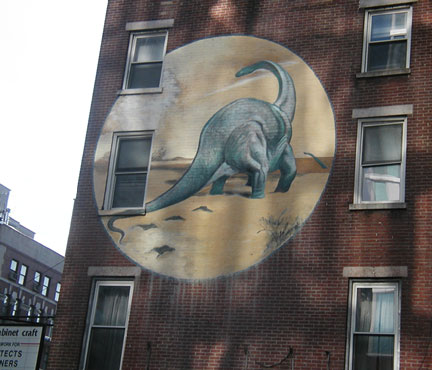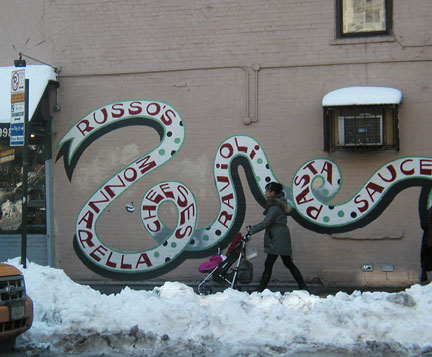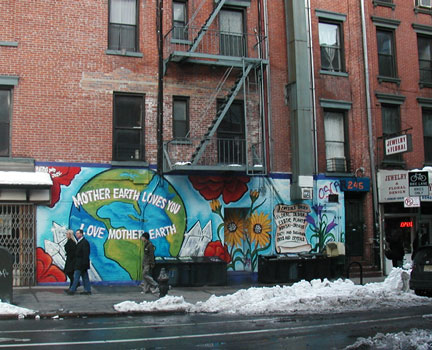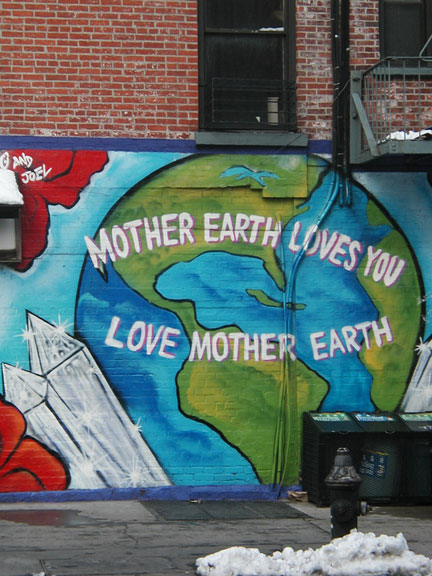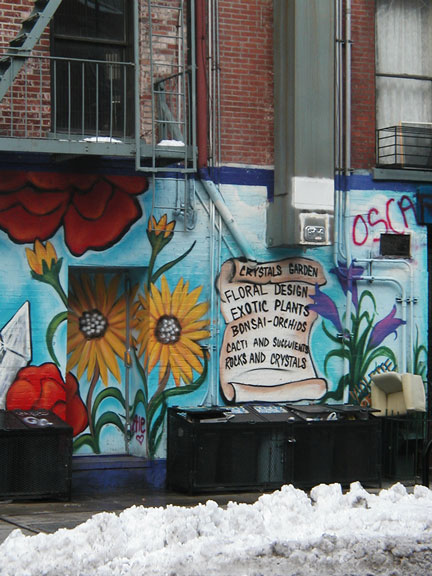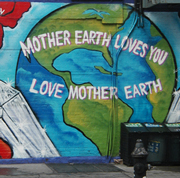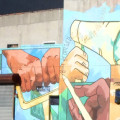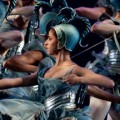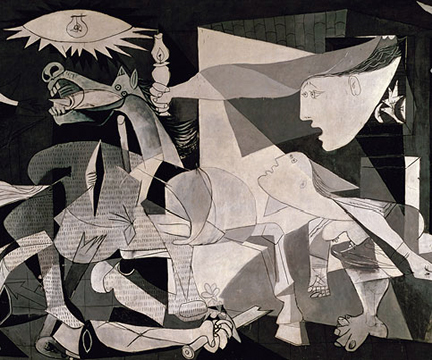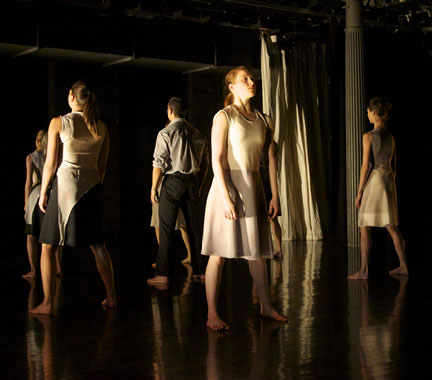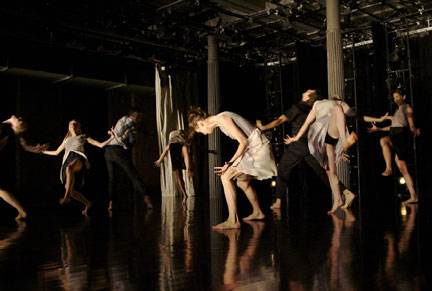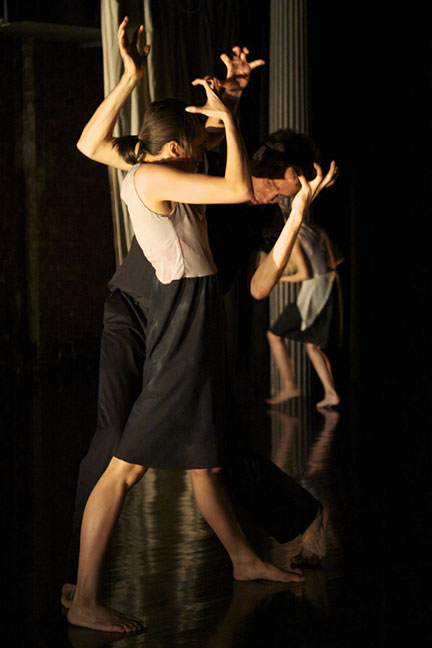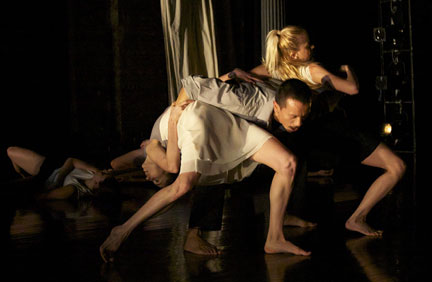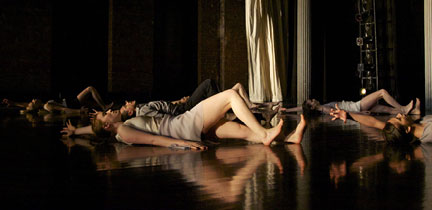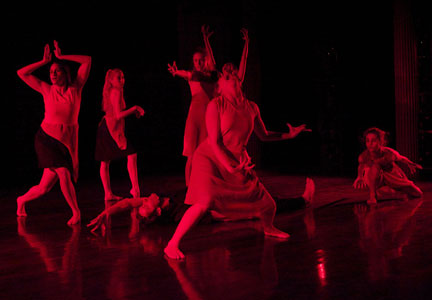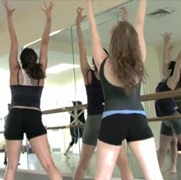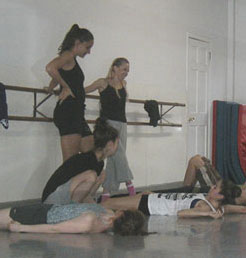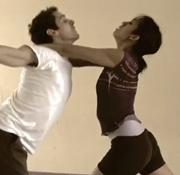Keigwin + Company’s Exit at the Joyce
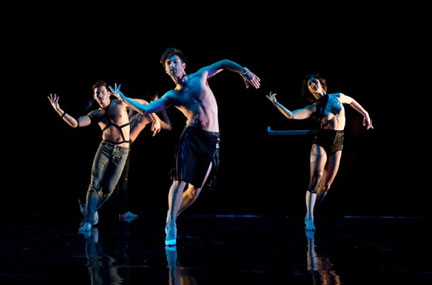
Keigwin + Company
Exit
Joyce Theater
Sunday, March 13, 2011
Keigwin + Company’s Exit was a great time from beginning to end. The evening length dance is set in a dark smokey night club. Along the back of the stage, there is an unadorned black wall containing an exit door that seems to lead to a back alley. The dancers are decked out in full club regalia, down to their torn fishnets.
They move with abandon and aggression, shedding costume pieces without inhibition. Several of the ensemble passages were just so exuberant and such pure entertainment. On the way out of the theater, I overheard someone in the audience say, “It would be fun to party with them!” I loved the dynamics of these dances, especially as the aggressive movement seems to melt into something unpredictably supple, silent and almost balletic at times.
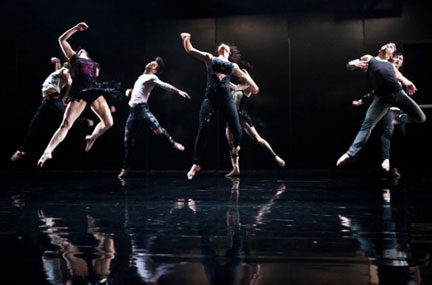
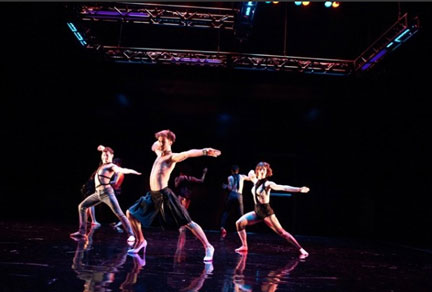
There were low key passages too, in which couples and trios mostly dealt with conflict amongst themselves. The women sought affection from the men and found themselves rejected. One man spurned the advances of another, while keeping his eye on a third man who had no interest in him. Along the black wall one dancer pins another, either for romance or for a fight. We’ve seen this behavior before and we’ve seen it dramatized on stage, yet nothing in the dance seems cliche.
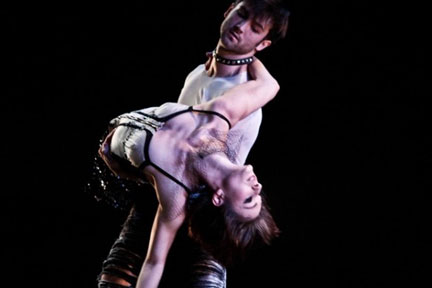
There was also plenty of camp. While one couple struggled with each other, a third man, dressed in nothing but a dance belt, a sheer shirt and a pair of skyscraper heels, paraded in through the exit door and lip synched to Sammy Davis Jr.’s I Gotta Be Me. In another scene, lit as if with a black light on Day Glo paint, the company, including the men, danced (and I mean really danced!) in white high heel pumps. They moved with ease and exhilaration, carrying it off in high style. Toward the end of the evening, poppers exploded from the wings launching confetti and metallic silver streamers, which stayed on the stage for the remainder of the dance. This worked beautifully when the streamers got caught on the dancers’ feet and swirled around them as they turned.
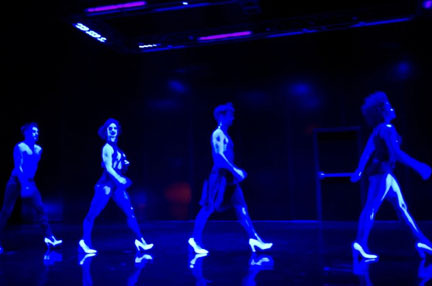
The fabulous music for this dance was composed by Jerome Begin and Christopher Lancaster, and performed by Jerome Begin. This was electronica at its best, with the beloved synth drums of club music sometimes accompanying beautiful noise and sometimes set against haunting melodies.
By the end of the evening, I felt as if I had a passing acquaintance with each of the dancers, caught a glimpse of their flamboyant side and their darkness, and was reminded of how great it feels just to get together, to dance and to party.
The company received a standing ovation. The woman sitting behind me squealed, “Can they do the whole thing over again? Right now?”
Ronald K. Brown and Evidence at the Joyce
Ronald K. Brown and Evidence
Joyce Theater
Sunday Evening, February 13, 2011
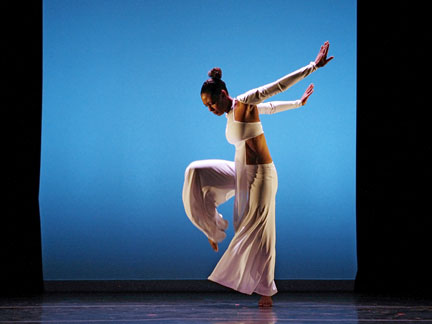
From the moment that I found my seat in the theater, I could feel the electricity in the air. A selection of Stevie Wonder songs filled the room and it was difficult to sit still. I soon found out that if one is in need of a lift, either physically, emotionally or spiritually, one will find it just by watching Ronald K. Brown’s Evidence perform.
The recurring theme in three of the pieces that were presented on Sunday night seemed to be the formation of community, either on a journey to a holy place as in Ife/My Heart, or uniting in the face of fear as in Lessons: Exotica/To Harm The Dangerous or to make the world a better place, as in On Earth Together. As far as I’m concerned, today’s society can’t be presented with these themes often enough. I feel that it’s the only thing that will help us to get beyond our current condition.
In Ife/My Heart, the dancers are all dressed in white. As happened several times throughout the night, the dancers began by moving along the periphery of the stage in a procession. Three families are traveling to a destination of togetherness. The first is dressed in traditional African clothing while the other two groups are wearing more classic contemporary costumes and this left me wondering if Brown was deliberately contrasting the traditional with the contemporary as part of the story.
The dancing is so riveting, so alive, and so deeply anchored in the spiritual. Though the dancers begin moving in a somewhat reserved fashion, the intensity and the fire grows as the piece progresses. The footwork becomes faster, the jumps higher, until everyone in the audience is feeling the spirit.
For You was a tear jerker about love and loss, a solo performed by Ronald K. Brown to Donny Hathaway’s rendition of the Leon Russell composition A Song For You. The earthiness of Brown’s understated movement along with the raw power of the lyrics of the song took me completely by surprise and really broke my heart.
From the start of the concert, the audience’s energy was up as high as I’ve ever seen it at the Joyce, but when the Stevie Wonder songs which accompanied On Earth Together began to play, things went into overdrive. Some of the movement in this piece is a little more subdued. What I loved about it was that every little vignette or conflict within the dance seems to end unpredictably with forgiveness and compassion and a call to love, which was just so beautiful.
The evening was full of great movement and great grooves – you could almost feel the sense of community amongst the audience. Maybe it’s because the dances and dancers of this company reach their audience so directly on such a visceral level. When they dance, it’s as if all the intellectualizing and pretense in the world is instantly stripped away so that matters could be addressed with complete honesty, directly to the heart and soul.
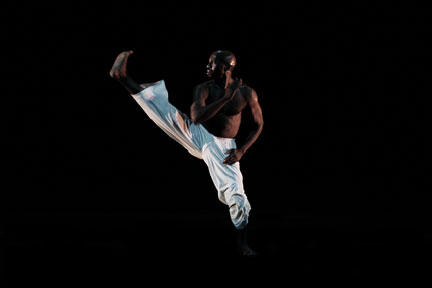
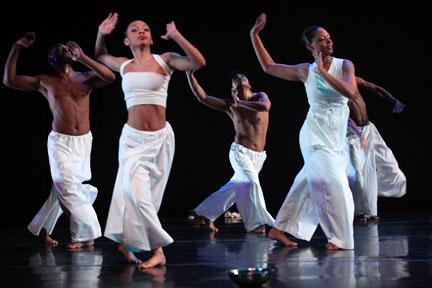
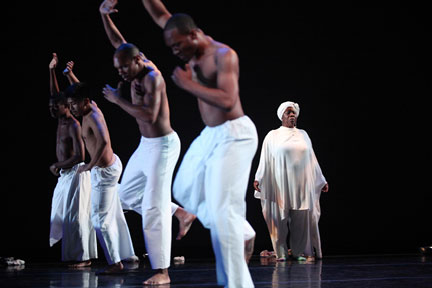
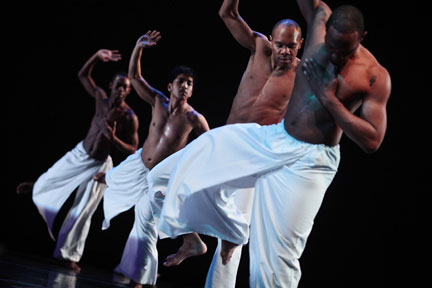
Norman Rockwell Behind The Camera at The Brooklyn Museum
“The balopticon is an evil, inartistic, habit-forming, lazy and vicious machine! It also is a useful, time-saving, practical and helpful one. I use one often—and am thoroughly ashamed of it. I hide it whenever I hear people coming.”
Eventually photography became so integral to his process that he wrote, “I challenge anybody to show me when I started to use photographs. I’ve always been knows as “The Kid With The Camera Eye’.
Norman Rockwell was born in New York City. He dropped out of High School to attend the Art Students League. By the age of 17 he’d become the Art Director of Boys Life Magazine. He was 22 when he did his first illustration for the Saturday Evening Post. The association between the publication and the artist lasted 47 years.
Some of his Saturday Evening Post cover illustrations have become a iconic images of American culture. Most people of a certain age are familiar with them. But it wasn’t until I saw the photos in this exhibit that I could even begin to imagine the amount of careful thought and attention to detail that went in to each illustration.
Not only was Rockwell drawing and painting these images, but more than anything, he was directing the models (mostly family and friends) to pose in the photos from which he’d work. Then he’d cobble the images together into the strong narrative in his paintings.
The exhibit reminded me of how clever and witty the narratives were. The words quoted above are the absolute truth. The photos and over head projector may have helped him become more prolific, but there’s no way that anyone other than a master of drawing and painting could have turned out these works.
The photos show us that when Rockwell wanted to depict his subjects in motion, he’d have someone off camera holding up the edges of the fabrics of their clothing, or holding up the ends of a girl’s long hair to give the effect. He even got down on the ground and helped to pose the dogs who appear in his paintings.
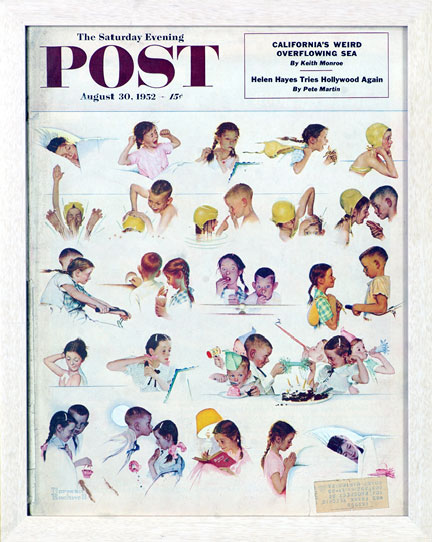
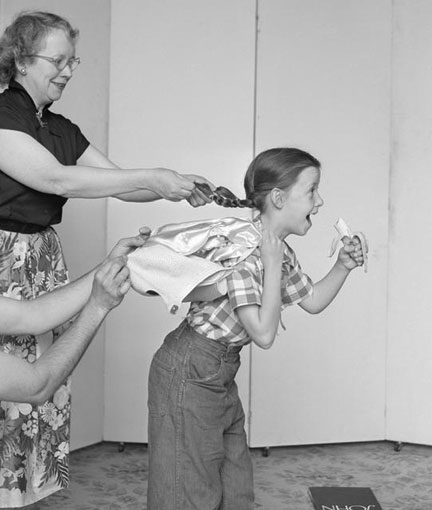
A Day In The Life of A Little Girl – Photo shows 4th image in top row
–
His enthusiasm for his subjects and their stories all but bubbles off the page. Of the photo session for the iconic painting Girl With A Black Eye (below), it was said, “By the time he finally achieved the perfect expression (on the girl’s face) he was on the floor laughing and pounding his fists.”
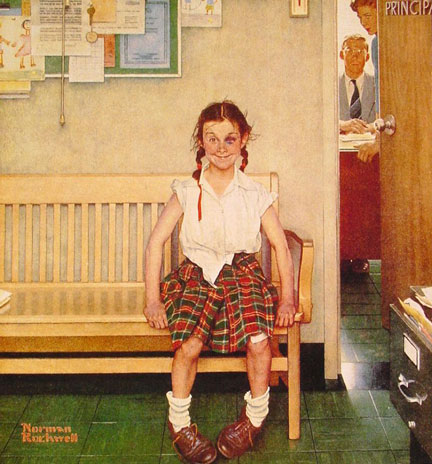
I got a great laugh from his 1946 painting titled Maternity Waiting Room. Back in those days, men were not invited into the Delivery Room when their children were being born, but instead were relegated to a Waiting Room. In this painting, Rockwell illustrates the way different men cope with the pressure and excitement of this milestone in their lives. We’re shown the Frightened Novice (far left), the Chain Smoker (smoking in the hospital, just as it was done in the old days), and the Tragedian (whose face is buried in the sofa cushion). But my favorites were the Father of Eight, who has fallen asleep on the couch, and the Hearty Salesman, who sees this as a moment to do his pitch and maybe close a deal or two before his baby is born.
The facial expressions that Rockwell was able to achieve are just sublime. They can tell an entire story in a moment’s time.
Of the painting below, originally made for The Saturday Evening Post but never published, it was said to be “a fitting metaphor for the artist’s own struggles with The Post as he weighed the end of their 47 year association.”
With a move to Look Magazine, Rockwell’s work traded away a bit of its cheeriness and humor and turned toward tackling the subjects of the day: Equal Rights, The War In Viet Nam, and Man’s Landing on the Moon. Below is Rockwell’s 1967 painting New Kids In The Neighborhood and the photos from which he worked.
The painting below, titled The Problem We All Live With, seemed much more grittier when I saw it “in person”. Though the images aren’t available, the museum showed photo studies of the fisted hands of the Federal Marshalls, as well as studies of the tomato that had been thrown at the wall.
This exhibit, which runs through April 10th, begins as an inspiring example of one artist’s work. But by the time you’ve walked through it, you’ve also traveled through half a century of American life, its wars, its politics, its new technology, and the drama and beauty of daily scenes and items which have long ago faded into history.
Here are some of the headlines seen on some of the Saturday Evening Post tear sheets:
September 4, 1943 – We Skip Bomb The Japs
November 27, 1943 – A Gay Short Story
August 16, 1947 – LICENSE TO KILL – The Truth About The Shocking Official Negligence Behind The Growing Death Rate On Our Highways
May 23, 1953 – Humphrey – The Man Ike Trusts With The Cash and Case History of a Maniac Who Was TURNED LOOSE TO KILL.
June 11, 1955 – How Communists Blackmail Refugees
May 25, 1957 – How Will America behave if H-BOMBS FALL
I recommend this exhibit very highly. Even if commercial illustration isn’t your thing, it is fascinating in and of itself just to see how the iconic paintings were composed and how they came to life.
There is so much going on at the Brooklyn Museum right now. Later in the week I hope to find time to write about the Lorna Simpson exhibit and the Tipi exhibit. (I also caught a glimpse of the “reOrder” exhibit, currently under construction, which promises to be amazing.)
Norman Rockwell: Behind the Camera
Through April 10, 2011
Robert E. Blum Gallery, 1st Floor
Norman Rockwell Behind The Camera from Norman Rockwell Museum site
Balopticon, a precursor to the overhead projector, used extensively by Rockwell
All photos courtesy of The Brooklyn Museum except for
Girl With A Black Eye – taken from here
Marriage Counselor – taken from the Norman Rockwell Museum
Maternity Waiting Room – taken from here
Miraculous
The city streets were covered with snow for the last seven weeks. Today was the first day of mild weather and I can finally see the soil in my backyard. When the last of the snow had melted away, this is what I found underneath it.
To me, it is nothing short of miraculous to be able to see these little beginnings kick off the renewal of Mother Earth. It becomes more awe inspiring with every passing year.
I can’t wait to get my garden started. Earlier this week I attended Brooklyn Dirt – Talks on Urban Farming and Gardening. It was a great prelude to the coming season.
The photo above is of daffodils. The one below is my neighbor’s magnolia tree.
Battery Park Pier
Dancers Chat with Zachary Catazaro
New York City Ballet
Dancers Chat with Zachary Catazaro
January 28, 2011
Photo by Paul Kolnik
On selected Friday evenings during New York City Ballet’s season, they offer an event called Dancers Chat about an hour and a half before curtain. Across the street from Lincoln Center, in a studio in the School of American Ballet (SAB – the official school of New York City Ballet), there are about one hundred chairs set up for guests who reserve seats. A moderator interviews one of the company’s dancers and opens the floor to questions from the audience. This was my first visit to a Dancers Chat and it turned out to be a wonderful experience that I highly recommend.
On this Friday evening, we met Zachary Catazaro, who dances in the corps. Throughout the informal 45 minute discussion, he was friendly and very forthcoming. The audience seemed very friendly too, and even joined in sharing anecdotes about performances that they’d seen while firing questions at him.
One of the highlights of the chat came when he shared his reflections on the experience of playing the Cavalier in a performance of The Nutcracker last year, with Rebecca Krohn as his Sugar Plum Fairy. He had one month to prepare for the role. He mentioned that he wanted to be in fighting shape because the costume has white tights. He said that throughout all the years that he’d watched the role of the Cavalier being performed, he’d always felt that it was a role he’d love to dance. But the reality of it was that the role is very hard. Once the Cavalier comes out, he doesn’t leave the stage. The dancers who had experience with this role advised him about just how to expend his energy.
Throughout the evening, the subject of the economical use of a dancer’s energy came up again and again. The host quoted Margot Fonteyn as saying that the hardest thing in dancing a ballet was knowing how to pace oneself and knowing when to breathe. I would have thought that the hardest thing would be remembering all that choreography, but he said that it’s relatively easy to remember.
He mentioned that years ago, the Second Act soloists in the Nutcracker also had to play Parents in the Party Scene and Mice in the Battle Scene and still have the stamina and focus left to perform their featured roles in the Second Act. It’s no longer done that way.
It was heartwarming to hear him say that on the night that he danced the Cavalier, the other dancers cheered him from the wings. He kept saying how supportive the company members are of one another even though they are always engaged in ‘friendly competition’. No barracudas in the company, regardless of what Hollywood films have to say on the subject.
He also said, though I’m not sure if he was joking, that the dancer who is in the role of Mother Ginger receives hazard pay for having to get up on stilts.
When asked about his favorite ballets, he listed Cortege Hongrois and Opus Jazz. He’s currently rehearsing Cortege, as well as Prince Siegfried in Swan Lake with Ana Sophia Scheller. He said he also hopes to dance the role of the Brown Boy in Dances At A Gathering.
He attended Public School, finishing High School in two years time so that he’d be able to devote himself full time to his ballet training when he joined SAB at the age of 16. He talked about some of the dancers who are taking college courses. Once he went into detail of the exhausting schedule that a ballet dancer must maintain, it’s absolutely amazing to me that any dancer could take on college courses on top of all that. He mentioned that some of them get together and study on Sunday evening, because that and Monday is the only time they have off.
About Alexei Ratmansky, he said that he loved working with him. He was very nice, very particular, and that he knows exactly what he wants, but he also listens carefully to the dancers. He is steeped in the history of Russian ballet.
Regarding partnering, he said that a dancer has to train in partnering from a young age. The type of build that a dancer has can affect his partnering skills. Short slender men are usually not as good at partnering, but he mentioned that Joaquin De Luz was the exception to this generalization.
He told us that Mr. B (George Balanchine) wanted “fingertip partnering”. As Mr. B taught it, the man does not help the woman spin in turns. He pointed out that at NYCB, partners do not hold hands in the “handshaking” position as the woman performs a promenade; instead the woman lays her hand on top of her partner’s and uses it for balance, the way she’d use the barre. When he said it, I could remember so many famous photos in which I’d seen the hands placed in that position. It’s so interesting to have these little details pointed out. It makes the ballet even that much more compelling to me. He also said that Peter Martins teaches the men to use their thumbs against the ballerina’s back to help her stay on her legs.
Our host recommended Merrill Ashley’s book Dancing for Balanchine, saying that Ashley is one of the best when it came to explaining exactly what Mr. B wanted from the dancers.
I’m really grateful to New York City Ballet for offering this program. It goes a very long way toward enriching the audience’s experience at the theater. I’d also like to send reverence to the moderator — I think that her name is Joan Quintano — who kept the conversation moving so easily that the time just flew by.
Related Reading:
East Village Murals
I am of an age where I harbor many romantic memories of the East Village. When I was a high school kid in the early 1970s, it was a place of music, art, fashion and revolution. Nothing could have been more exciting, except perhaps for SoHo, where much of the art world had begun to gravitate.
Needless to say, it is no longer the same place. I didn’t see any of the major chain stores having invaded, but NYU has swallowed up an awful lot of it. Some sweet little independent shops, mostly small restaurants and bakeries remain. And then there’s the Theater For The New City, which brought me to the neighborhood on Sunday. More to come about that later.
These are some of the murals that grace the walls of the East Village.
Another January Morning in New York City
It’s been one month since the first blizzard of this season. The accumulations from that first snowfall are still on the ground. There’s a song lyric that goes “They say a snow year’s a good year” and if there’s the tiniest grain of truth in that, this year will be spectacular.
Some more snow arrived this morning and there’s more to come tonight. It looks so beautiful and magical.
Sneak Preview of Yesid Lopez’s Bolero at APAP – DeMa Dance Company
Choreographer and Artistic Director Yesid Lopez’s latest work for the DeMa Dance Company was inspired by Pablo Picasso’s mural Guernica (detail pictured above),which depicts the ravages of the Spanish Civil War.
I had the opportunity to watch Yesid set this dance on the company last month and to speak to him a little about his process. I felt that this dance was a huge undertaking, in that Yesid was attempting to deal with the horror and tragedy of war through the lens of the humanity of its victims.
Last weekend, at APAP at Dance New Amsterdam, the DeMa Dance Company performed a sneak preview of what will become an evening length piece based on the life and work of Picasso. This piece is called Bolero Stravaganza.
I’d seen Yesid explore darker themes before, as he did in Thirst of Ruin. But Bolero takes things to a more heart wrenching level.
The piece opens with the dancers standing still, their backs to the audience. One dancer faces the audience and begins the piece, her face contorted in a silent scream, her fingers tensed into claws, her movement sharp and staccato as she begins to sink.
The dancers represent a civilian population, being made to pay the ultimate price in the battle between warring factions of those with power. Each dancer, individually or with a partner, is put through the paces of facing the brutality and the horror of war. They strike poses and use gestures which reflect those of Picasso’s subjects in the Guernica, and Peggy Casey’s costumes in muted grays and greens echo the colors of the mural.
Even while the dancers are holding their own places within the formation, a stormy atmosphere of chaos erupts.
In a very dramatic moment, the dancers line up to face a firing squad.
As I said when I first saw this piece in rehearsal, from the very beginning of this dance it struck me that even in the midst of the turmoil of war, when its victims face one another, it is with expressions of compassion. The bodies of the wounded are carried. The dancers run to one another and find shelter. When they are moving in unison, even if the movement seems to convey nothing but pain and fear, it also seems to be creating an expression of their brotherhood.
I have seen this company grow from humble beginnings in the summer of 2009 to where they’ve arrived today, as a cohesive unit with a distinctive and edgy style emerging. Still the dancers remain as fierce individuals in their own right. They gave a couple of great performances last weekend and I was gratified to see how well received they were.
Big congratulations are in order for Yesid Lopez and the DeMa Dance Company.
All photos by Ceren Salman

